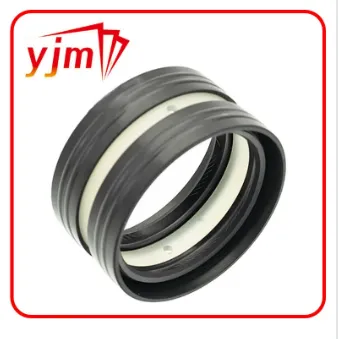The Unsung Heroes of Engine Protection: Understanding Automotive Shaft Seals and Oil Seals
When it comes to vehicle maintenance and engine reliability, it’s easy to overlook the small components that play big roles. Among these essential parts are automotive shaft seals, car engine oil seals, and other types of car oil seals. These seals are designed to prevent fluid leaks, reduce friction, and keep contaminants out of critical engine systems. In this article, we’ll explore their function, significance, and tips for maintenance.

What Are Automotive Shaft Seals and Why Are They Important?
Automotive shaft seals also called rotary seals or radial lip seals, are used in areas where rotating components pass through stationary housings, such as crankshafts and camshafts. Their primary job is to retain lubricants (like oil or grease) inside the engine or transmission while preventing dust, dirt, and water from entering.
A typical automotive shaft seal has:
An inner metal ring for structural integrity
An elastomeric outer shell for tight housing fit
One or more sealing lips to ensure fluid retention
These seals are essential in areas like:
Engine crankshaft (front and rear)
Transmission shafts
Axle and differential shafts
When these seals wear out or get damaged, you might notice oil leaks, unusual noises, or even transmission slipping. Timely inspection and replacement can save the engine from severe damage.
The Role of the Car Engine Oil Seal in Engine Longevity
A car engine oil seal is a specific type of shaft seal placed in key locations within the engine. Its role is to retain engine oil while allowing rotating components, such as the crankshaft or camshaft, to operate smoothly.
There are several types of engine oil seals:
Front crankshaft oil seal – keeps oil in while the crankshaft turns at the front of the engine
Rear main seal – located at the rear of the crankshaft; a common source of oil leaks
Camshaft oil seals – prevent oil leaks around the camshaft ends
Valve stem seals – control the amount of oil entering the valve guide area
Without properly working car engine oil seals, engines can suffer from:
Oil starvation
Increased wear and friction
Oil contamination in the combustion chamber, leading to smoke and reduced efficiency
Replacing a faulty engine oil seal can be labor-intensive, but it's far cheaper than repairing a damaged engine. It’s best to inspect seals during major services, such as timing belt replacements or head gasket repairs.
Choosing and Maintaining the Right Car Oil Seal
Not all car oil seals are made equal. Selecting the right material and type is crucial for long-lasting performance. The operating environment—temperature, pressure, chemical exposure—should dictate the seal material.
Common materials used in car oil seals:
Nitrile rubber (NBR): Common in most vehicles; handles moderate temperatures and oil exposure
Viton (FKM): Suitable for high-temperature and high-performance engines
Silicone rubber: Used in valve seals for excellent heat resistance and flexibility
Signs a car oil seal may be failing:
Oil puddles beneath the vehicle
Visible leaks around engine or transmission components
Burning oil smell
Dropping oil levels despite regular top-ups
To maintain your vehicle’s car oil seals:
Always use the recommended engine oil to reduce chemical wear
Avoid overfilling or underfilling your oil
Replace seals proactively during engine overhauls
Inspect for cracks, hardening, or wear during oil changes
Quality aftermarket or OEM seals are readily available and relatively inexpensive, though labor costs may vary based on the seal location.
Why Properly Sealed Engines Perform Better
The main job of engine oil seals is to make sure oil stays where it should—lubricating moving parts and not leaking onto the ground or other components. When these seals fail, more than just oil is lost. You risk reduced engine performance, overheating, and eventually major mechanical failures.
Benefits of maintaining proper oil seals include:
Improved engine efficiency
Extended component life
Lower maintenance and repair costs
Environmental protection from oil leakage
Whether it’s a simple car oil seal or a complex automotive shaft seal, ensuring that every seal in your engine is working correctly is a smart, long-term investment in your vehicle.
Though small in size, automotive shaft seals, car engine oil seals, and other types of engine oil seals are vital to keeping your car running efficiently and reliably. They protect your engine from internal and external damage by ensuring fluids stay in and contaminants stay out. Regular inspections, proper seal selection, and timely replacements are key to avoiding costly repairs and maintaining your engine's health for the long haul.
-
The Ultimate Guide to Car Repair Kits: Tools and Essentials Every Driver Should Own
Nuacht Aug.01,2025
-
The Complete Guide to Oil Pan Gaskets: Sealing Engine Leaks the Right Way
Nuacht Aug.01,2025
-
Preventing Oil Leaks: A Complete Guide to Oil Pan Gaskets and Drain Seals
Nuacht Aug.01,2025
-
Everything You Need to Know About Oil Pan Gaskets and Drain Plug Seals
Nuacht Aug.01,2025
-
Essential for Car Owners: How to Use a Car Repair Kit to Deal with Minor Breakdown
Nuacht Aug.01,2025
-
Comprehensive Guide to Engine Oil Sump Gaskets and Related Seals
Nuacht Aug.01,2025
-
The Ultimate Guide to Boat Propeller Bearings and Trailer Wheel Bearings
Nuacht Jul.31,2025
Catagóirí táirgí















